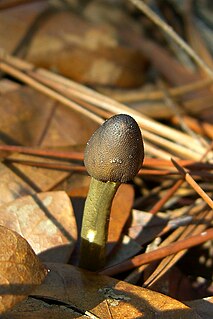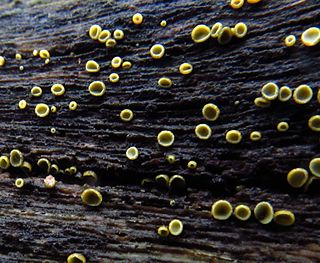Related Research Articles

Mycology is the branch of biology concerned with the study of fungi, including their genetic and biochemical properties, their taxonomy and their use to humans, including as a source for tinder, traditional medicine, food, and entheogens, as well as their dangers, such as toxicity or infection.

Malassezia is a genus of fungi. It is the sole genus in family Malasseziaceae, which is the only family in order Malasseziales, itself the single member of class Malasseziomycetes. Malassezia species are naturally found on the skin surfaces of many animals, including humans. In occasional opportunistic infections, some species can cause hypopigmentation or hyperpigmentation on the trunk and other locations in humans. Allergy tests for these fungi are available.

The Hypocreales are an order of fungi within the class Sordariomycetes. In 2008, it was estimated that it contained some 237 genera, and 2647 species in seven families. Since then, a considerable number of further taxa have been identified, including an additional family, the Stachybotryaceae. According to the Catalog of Life, As of April 2021 the Hypocreales contains 6 families, 137 genera, and 1411 species.
Index Fungorum is an international project to index all formal names in the fungus kingdom. As of 2015 the project is based at the Royal Botanic Gardens, Kew, one of three partners along with Landcare Research and the Institute of Microbiology, Chinese Academy of Sciences.

The Saccharomycetaceae are a family of yeasts in the order Saccharomycetales that reproduce by budding. Species in the family have a cosmopolitan distribution, and are present in a wide variety of habitats, especially those with a plentiful supply of carbohydrate sources. The family contains the species Saccharomyces cerevisiae, perhaps the most economically important fungus.

Pier Andrea Saccardo was an Italian botanist and mycologist.

August Johann Georg Karl Batsch was a German naturalist. He was a recognised authority on mushrooms, and also described new species of ferns, bryophytes, and seed plants.

The Dermateaceae is a family of cup fungi in the order Helotiales. Most species in this family are plant pathogens but some are saprobes.

Calostoma is a genus of 29 species of gasteroid fungi in the suborder Sclerodermatineae. Like other gasteroid fungi, Calostoma do not have the spore discharge mechanism associated with typical gilled fungi (ballistospory), and instead have enclosed spore-bearing structures. Resembling round puffballs with raised, brightly-colored spore openings (osteoles), elevated on a thick, gelatinous stalks, species have been collected in regions of deciduous, temperate, tropical or subtropical forests. Their distribution includes eastern North America, Central America, Asia, and Australasia. The common name given to some species, "prettymouth", alludes to the brightly-colored raised openings (osteoles) that may somewhat resemble lips. Other common names include "hotlips" and "puffball in aspic".

The Stereocaulaceae are a family of lichen-forming fungi in the order Lecanorales. It contains five genera. Species of this family are widely distributed in temperate boreal and austral regions.

Ochrolechia is a genus of crustose lichens in the family Ochrolechiaceae.
The Microthyriaceae are a family of fungi with an uncertain taxonomic placement in the class Dothideomycetes.
The Asterinaceae are a family of fungi in the monotypic class Asterinales.
Caudella is a genus of fungi in the Microthyriaceae family.
Asteronia is a genus of fungi in the Microthyriaceae family.
Cryptodiscus is a genus of lichen-forming fungi in the family Stictidaceae.
Arthopyrenia is a genus of fungi within the Arthopyreniaceae family. The genus has a widespread distribution, and contains about 117 species.

František Kotlaba was a Czech botanist and mycologist.

Xylodon is a genus of crust fungi in the family Schizoporaceae.
References
- ↑ Lumbsch TH, Huhndorf SM. (December 2007). "Outline of Ascomycota – 2007". Myconet. Chicago, USA: The Field Museum, Department of Botany. 13: 1–58. Archived from the original on 2009-03-18.
- ↑ "Meliolaster - Search Page". www.speciesfungorum.org. Species Fungorum. Retrieved 6 November 2022.